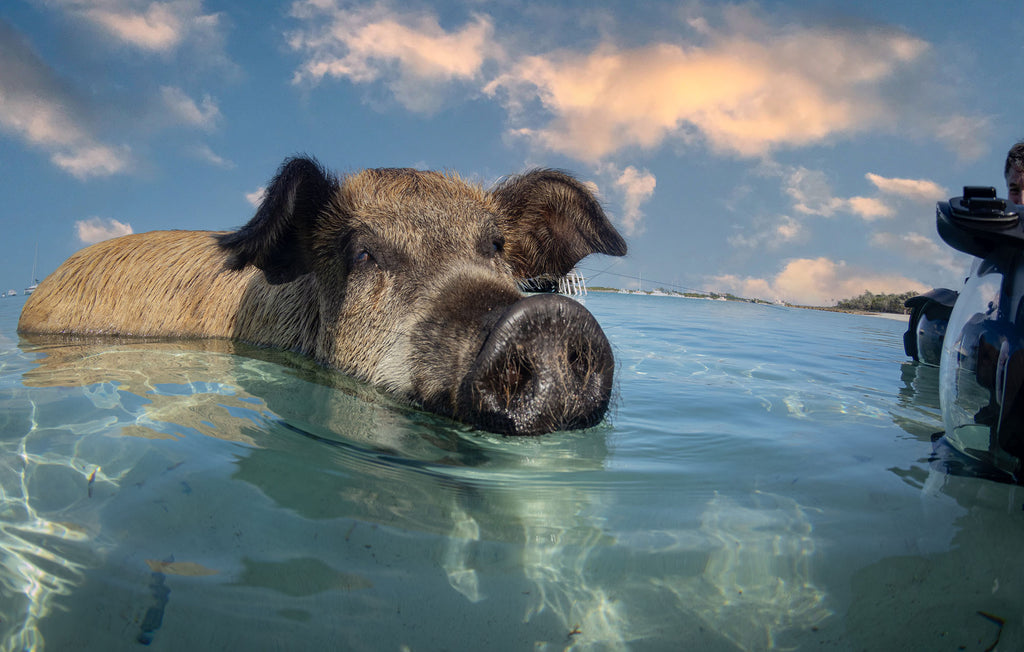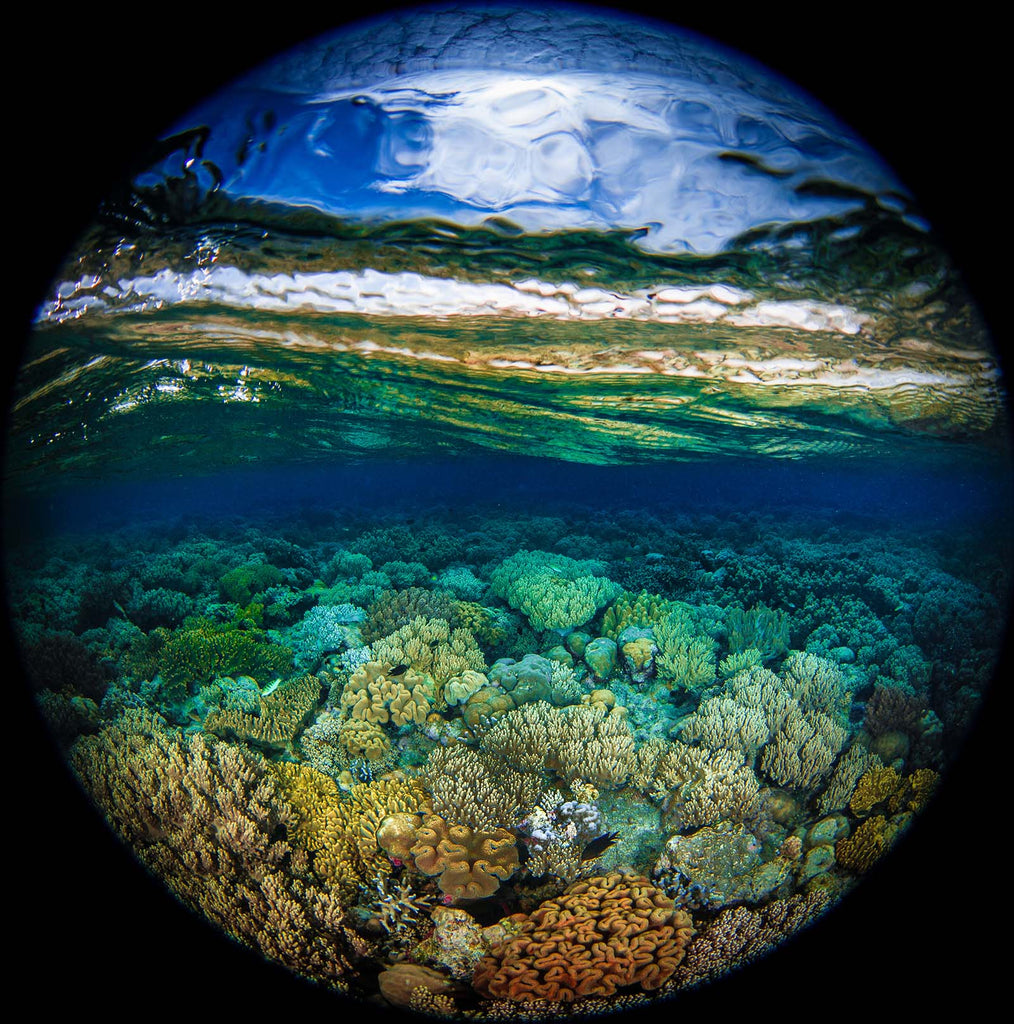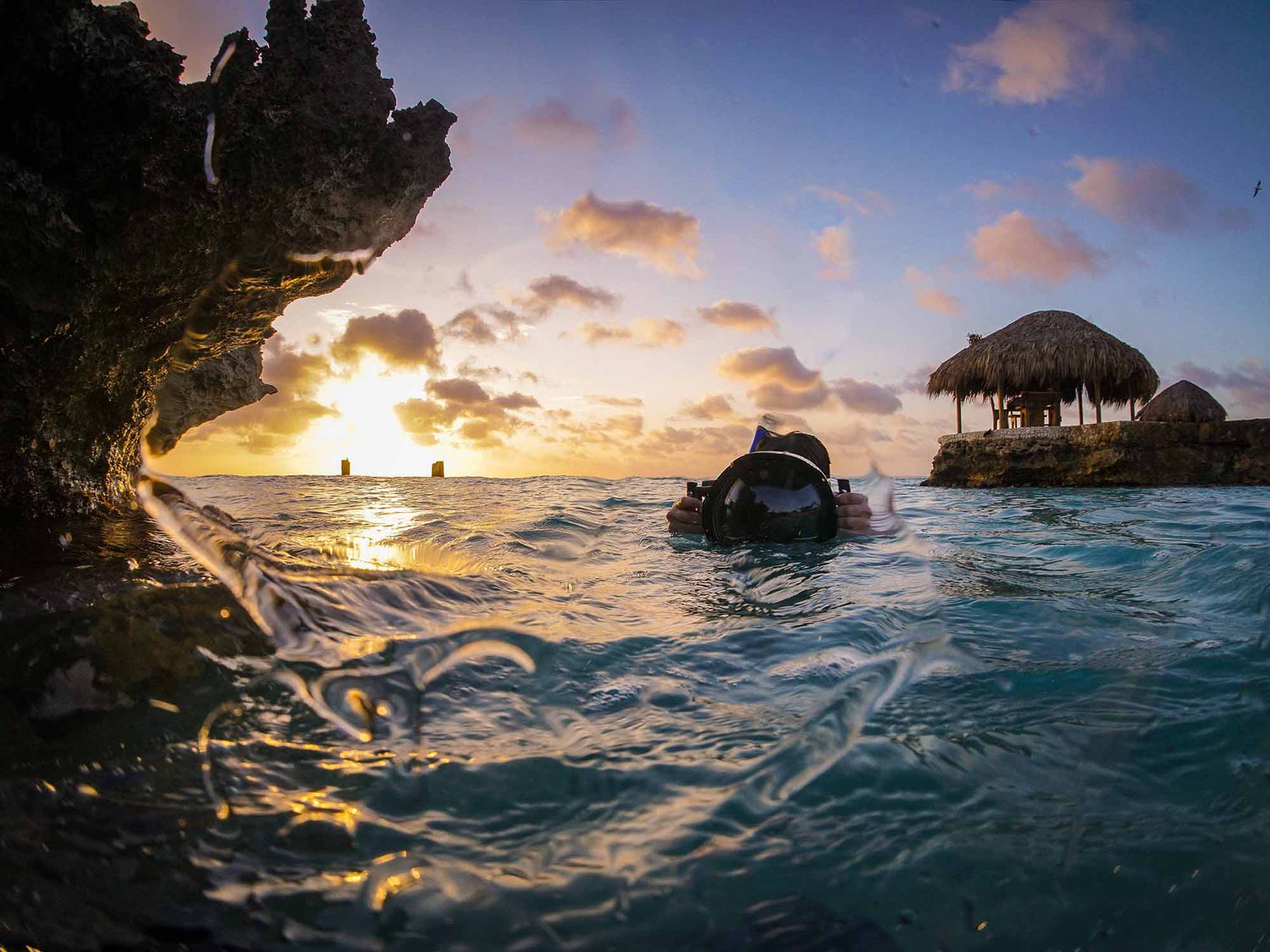Split shots, sometimes called “over-unders,” refer to photos where half of the frame is underwater and half of it above water. This presents a variety of special challenges for the photographer. Dynamic range and lighting can all be worked around - but water droplets are an ever-present pain.
The Problem with Water Droplets
You can take a clear image through a wire fence, yet a small droplet of water on your dome in the wrong spot can totally ruin an otherwise perfect split shot. We’re typically shooting at relatively small apertures – F8 and smaller – to get enough depth of field for both the wet and dry portions of frame in focus at the same time. So a big drop of water on the front of your dome will a fuzzy blob in your photo.
Dome ports for underwater photography typically come in a variety of diameters, typically between 4 and 10 inches. Shooting with a larger diameter dome will help you to control the water line and will also cause water droplets to be smaller and less apparent in your image. Droplets will also be less prominent in your frame when shooting at wider focal lengths.
Even in the calmest seas or a pool, small droplets of water are attracted like magnets to your port. They will be there regardless of what you do. Minimizing the quantity and size of these blobs is the first place to start.

The best solution, if you are able, is to not let your dome get wet in the first place and carefully dip it in only as far as you need to go. This is almost impossible when swimming unless you rest your housing on a raft or float. © Steve Miller
Keeping Your Dome Dry
It is virtually impossible to submerge the bottom half of your dome port while keeping the top half dry. There are times when you are shallow enough to carry a micro fiber lens cloth and actually dry off the top half of your dome in-between shots. But a microfiber cloth will work against you once it gets drenched. I find a wet cloth will leave a million tiny droplets instead of the big ones that are easy to repair in the edit.
Another technique is called “dunk and shoot.” You start by lining up your image. Then fully submerge the dome right before you want to take a photo, lifting or rotating it steadily back to the proper orientation for the shot. You should notice more “sheeting” and less droplets.

Get creative! When using the "dunk and shoot" technique to wipe your dome, shooting a burst can capture interesting refractions of the light and color as the water sheets down the dome. © Steve Miller
How to Prevent Water Droplets
Spit is famous for defogging a mask, because it creates a thin film that is clear enough to see through. This natural “film” also helps your dome port shed water in a more uniform sheet. When the water line drops down like a curtain there will be less individual droplets to repair. So yes, some photographers spit on their domes. It’s the most reliable (and least expensive) way to reduce water droplets on your dome.
If spit makes you squeamish, you can alternatively try a mild, eco-friendly shampoo or dish soap. But it will only work until the soap washes away – so work quickly and re-apply as needed.

It is tempting to look over the top of the housing and "shoot from the hip" but small changes in the tilt of the housing make big changes in your scene. It's always preferable to look through the lens when shooting split shots and the Straight Enhanced Magnifying Viewfinder can be a big help here. © Steve Miller
I have found that polishing my dome before going in can also help. There are 3 levels of polish that are used for buffing out scratches on your port. NOVUS #3 is simply a plastic cleaner and polish. It won’t remove scratches, but it will make your dome smoother (you can feel this with your hand). This will help the water shear off more cleanly.
Some shooters have reported good results with an acrylic friendly Rain-X product. But in our testing we found that it reduced sheeting of the water and created more individual droplets (as advertised). We’re also not sure of the environmental impact or the possibility of chemical incompatibility with various o-ring compounds.

The worst thing that can happen is for your camera to focus on the droplets instead of the subject. Using a smaller aperture increases your depth-of-field and your chances that the subject will be in focus.
Water Droplets vs. Fog
Let’s be clear that water droplets should always be on the outside of your dome port. Water droplets on the inside are a big problem and you should get your system out of the water immediately.
If you have fog on the inside of your dome, you have too much humidity inside. Make sure the housing is completely dry inside and assemble it in a climate controlled (air conditioned) room next time.
If you have fog on the outside of your dome, it’s because of a large difference in the temperature inside compared to outside. This should go away pretty quickly once things become the same temperature.
Removing Water Droplets in Editing
Expect to do some editing on your split shots. Most are improved by some corrections to balance dynamic range between the upper and lower halves of the image. Use your editor’s repair tools to carefully remove any obtrusive water spots.
Not all droplets are the same. If they are in your sky, cloning them out or using the repair tool will be very satisfying. If they cross your model’s face there may be nothing you can do. However, editing tools are getting smarter and there are many content-aware and AI-based tools that may soon be able to save even the most pock-marked split shot.

Ambassador Steve Miller has been a passionate teacher of underwater photography since 1980. In addition to creating aspirational photos as an ambassador, he leads the Ikelite Photo School, conducts equipment testing, contributes content and photography, represents us at dive shows and events, provides one-on-one photo advice to customers, and participates in product research and development. Steve also works as a Guest Experience Manager for the Wakatobi Dive Resort in Indonesia. In his "free" time he busies himself tweaking his very own Backyard Underwater Photo Studio which he's built for testing equipment and techniques. Read more...One approach to water droplets is to shoot your "overs" separately and add them in Photoshop. This also solves the famous tonal range issue caused by the sky exposure. © Steve Miller
Related Articles
How to Shoot Split Shots (Half-In, Half-Out of the Water)
Circular Fisheye Showdown: Canon 8-15mm vs Olympus FCON-T02
Why You Need a Fisheye Lens Underwater
Beach Photography with the Olympus TG-6 and Fisheye Lens
Underwater Pool Photoshoot: What We Did WRONG and What We Did RIGHT













![Manual Camera Exposure VS Manual Strobe Exposure for Underwater Photography [VIDEO]](http://www.ikelite.com/cdn/shop/articles/Manual_Exposure_Blog_Cover.jpg?v=1694783175&width=1440)
![Sony ZV-E1 Camera Settings for Underwater Videography [VIDEO]](http://www.ikelite.com/cdn/shop/articles/ikelite-sony-zv-e1-underwater-camera-settings.jpg?v=1697217398&width=2000)